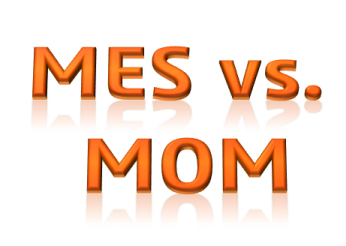In the world of manufacturing, we use a lot of acronyms. ERP, QC, BTO, service BOM software, DAMA, ISO, MRP, OEE, SCADA, and so on (we created a long list of acronyms & definitions here.) Those of us in the manufacturing business would hardly know how to communicate without the alphabet soup that is manufacturing today!
But sometimes, acronyms get in the way. Every few years it seems a new debate starts over whether a core capability acronym should be reviewed or possibly updated. Lately, I’ve noticed a battle brewing about what term to use when describing the systems that control processes on the plant floor—the piece that sits between manufacturing ERP software and the actual machines. Automation World recently published this article on “MES vs. MOM: What’s in a Name?” and we just published our article “Do you know the difference between MES and MOM? ” Clearly this is a hot topic now!
Some argue that MES (Manufacture Execution System) is the right acronym. After all, that’s what these systems have always been called.
Lately, however, it appears there is now a trend geared more towards the use of MOM (Manufacturing Operations Management) software. If you are with this group, the argument goes that expectations today have grown to beyond what MES systems have done in the past, and are now geared more towards the management of operations across plants – a wider “footprint,” so to speak. Manufacturers are not just executing production processes one plant at a time anymore; they’re orchestrating the management of operations across a global plant floor with a supply chain that extends to all four corners of the world.
Does it matter? I think it does. We need to agree on terms if we’re going to talk about a subject as complex as manufacturing. If we use the same terms, but mean different things, we won’t be communicating. I know others will argue that the acronym isn’t what’s important, it is the description … but the problem is that if we all use acronyms and not the complete descriptions, then consistency is really needed. Most would argue that there is a clear difference in the meanings of MES and MOM, and this difference affects how people understand the larger issue of manufacturing transformation.
So, in an effort to try and help clarify and provide guidance from the perspective of Manufacturing Transformation, here are our definitions:
MES (Manufacturing Execution System):
This is a shop-floor application that directs the activities of labor, resources and materials to provide the right information at the right time. According to one of our authors, Michael McClellan in his book Applying Manufacturing Execution Systems published in 1997 (ISBN 1574441353), these systems show the manufacturing decision maker “how the current conditions on the plant floor can be optimized to improve production output.” An MES is largely a siloed system, although it can be interfaced (not necessarily easily) to other plants and with ERP.
MOM (Manufacturing Operations Management):
This is a more comprehensive solution that directs more than just the traditional processes on the shop floor, but also other related operations such as warehouse, shipping, quality, maintenance, and labor. In addition, a full MOM solution will offer some sort of visibility into supply chain operations and manufacturing “big data,” so as to deliver decision support in the form of manufacturing intelligence. Although it can drill down to the plant floor, its power is in the aggregated data and larger view of the manufacturing landscape that it provides, whether applied to a single location or to an enterprise. Because it is more comprehensive, MOM:
- Has access to more data in its architecture, so that means can deliver more intelligence to better support decision makers
- Readily enables continuous improvement through better tracking and reporting
- Supports operational agility by making process changes easier and faster to implement
- Can be more easily linked across multiple facilities, so as to deliver real-time, enterprise views of operations
- Is effective at helping to identify and deploy best practices across operations – and functions
Looked at this way, one could say that MES is really a subset of MOM. That makes sense, since MOM developed from MES. Stated differently, MES systems tend to comprise plant-based applications; MOM is more of an enterprise solution to manage the larger footprint of manufacturing, whether for one plant or across an enterprise.
More to the point, MOM is an essential capability for the manufacturing transformation currently underway, such as what is now being described as the 4th Industrial Revolution. Industry leaders can’t afford to run every plant as a stand-alone operation, not if they expect to maintain their product quality, adjust to supply chain issues, design-anywhere-manufacture-anywhere (DAMA), and continuously improve.
Manufacturing Execution System (MES) software won’t go away. But it seems clear that manufacturers, who think in terms of global performance, quality, and agility, should now be thinking in terms of MOM.
I would appreciate your feedback on the acronym debate … feel free to post a comment below.

